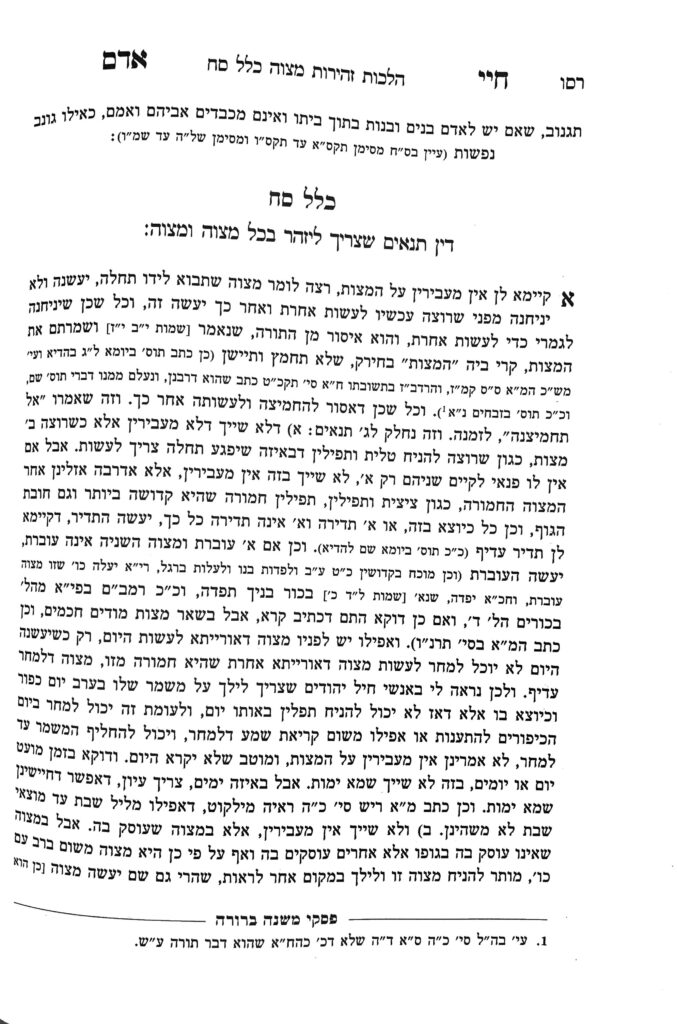We are continuing in siman 1. We are beginning the third limitation to the concept of ain ma’avirin.
The Chayei Adam writes that included in the concept of ain ma’avirin is the idea not to delay performing a mitzvah (as we learned from the pasuk of ushmartem es hamatzos, see shiur 1370). This pasuk teaches us not only that one should not disregard an opportunity to do a mitzvah, but also that as soon as the opportunity presents itself, one should take advantage of it.
The Gemara discuss this concept in the context of Purim in a leap year. The Gemara suggests that Purim should be in the first Adar, because of the concept of ain ma’avirin. The Turei Even asks that if Purim is not meant to be in the first Adar, there should be no issue of ain ma’avirin, because if Purim is not meant to be celebrated in the first Adar, the mitzvah has not yet presented itself. He explains that Chazal understood that there is a concept of doing a mitzvah as quickly as possible, so even if it is not considered classic ain ma’avirin (because the mitzvah has not yet presented itself), it is parallel to the concept of ain ma’avirin.
The Gemara continues, and says that we celebrate Purim in the second Adar because we prefer to be masmich geulah l’geulah, to connect between the redemption of Purim and Pesach. If so, we see the concept of ain ma’avirin has an exception; namely, when it is possible to do the mitzvah in a better way, that consideration supersedes the concept of ain ma’avirin.
Thus, the Chayei Adam writes that ain ma’avirin only applies when the level of quality of performing the mitzvah will be the same whether it is performed now or later. However, if by waiting a day or two, one will be able to perform the mitzvah in a better way, one should wait. The Chayei Adam points out that the Shulchan Aruch paskens in accordance with this concept in siman 426, in hilchos kiddush levana. There, the Shulchan Aruch writes that the best time to perform kiddush levana is motzei shabbos. Kiddush levana is equivalent to greeting the King, so the most appropriate way to perform it is when one is dressed in their finest and smelling their nicest; ie. after Shabbos when they are still in their Shabbos clothing. If the opportunity for kiddush levana presents itself earlier in the week, pushing off the mitzvah until motzei shabbos would be a form of ain ma’avirin. (Although it is not a question of two mitzvos, it is a question of performing one mitzvah at two different times.) The Shulchan Aruch writes that one should wait until Motzei Shabbos in order to perform the mitzvah. Thus, we see that it is preferable to push off performing a mitzvah in order to perform it in a better way.
However, the Chayei Adam adds that the Sefer Chassidim holds that one should not push off performing the mitzvah. He holds that ain ma’avirin is so compelling that performing the mitzvah in a better way at a later time is not a reason to override ain ma’avirin.
Accordingly, in siman 426, the Mishnah Berurah brings that the Bach and Gra disagree with the Shulchan Aruch, and hold that a person should not push off the opportunity to perform kiddush levana. The Chayei Adam seems to be inclined towards the Sefer Chassidim, but the proof from the Sefer Chassidim is debatable.
We will give other applications of this concept in the next shiur, be’ezras Hashem.
Summary
There are three limitations to the application of ain ma’avirin:
- If one is only able to fulfill one of the mitzvos
- If the person is not an active participant in the current mitzvah, but only a spectator. Although there is a concept of b’rov am, the concept of ain ma’avirin does not apply.
- If one can perform the mitzvah in a better way by waiting until a later time



